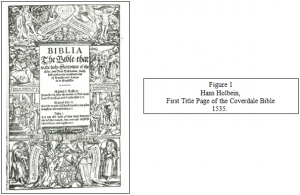Courtney Jensen Peacock and Dr. Martha Moffit Peacock, Visual Arts
When I originally applied for an ORCA grant, I submitted a proposal to do research on the readmission of the Jews into England in 1655. After receiving the grant, I traveled to London where I was able to examine contemporary sources, including prints, newspapers, and books. After obtaining permission to use the facilities at the Warburg Institute and the Department of Prints and Drawings at the British Museum, I spent five weeks immersed in primary and secondary sources.
As a history major and an art history minor, I have always been intrigued by the ability of art to help us better understand the past. Therefore, I decided to focus my studies on printed images and their accompanying texts. After extensive efforts to find prints relating to the Jewish resettlement, I discovered only three images. Due to the limited material, I considered perhaps revising my topic; after consulting with my faculty mentor, I decided to redirect my efforts to a more viable topic. During my search for prints depicting Jews, I came across frequent depictions of the Tetragrammaton, the ancient four-lettered Hebrew symbol for God (Figure 1). I was aware that this symbol was uncommon before this period, and I became intrigued by its revival at this particular time in history.

I began to collect all of the prints and paintings with this symbol and realized that it was linked to the birth of Protestantism in the sixteenth century. In England, in particular, Protestantism played an important role in politics as it became linked to the monarch’s search for independence from the Pope in Rome. Church and state were combined under the ruler ship of a divinely-appointed monarch; as England was one of the only European nations to adopt Protestantism as its official religion, English nationalism became closely linked to the new Anglican church. Over the course of the century, the Tetragrammaton became an important symbol for the Protestant monarchs as well as a sign of England’s status as a chosen nation. My research focused on the arrival of the Tetragrammaton into the English consciousness by examining texts and images from 1531, when the Tetragrammaton first appeared in an English text, to the 1570’s, when it was fully established as a recognizable symbol of English Protestantism.
Prior to its becoming a Protestant symbol, the Tetragrammton had been associated with Cabbala as well as Catholicism. Early in the century, writers such as Desiderius Erasmus and John Bale had condemned the symbol because of its mystical, superstitious overtones. My goal was to trace the transformation of the Tetragrammaton into an acceptable sign of English Protestantism.
Through the course of my research, I focused on a number of themes, issues and events that I felt facilitate the widespread recognition of the Tetragrammaton as a Protestant symbol. These included: the rise of iconoclasm, particularly the Calvinist opposition to corporeal depictions of God; Protestant interest in the Old Testament; the monarch’s decision to emulate rulers from ancient Israel who had combined church and state; and the desire for England to be seen as a new Israel. I used my research to write an honors thesis, entitled “A New Israel: The Tetgrammaton and English Protestants”, and this paper was awarded the 2005 Phi Kappa Phi Paper Competition Second Place Award.
In conjunction with my studies of the Tetragrammaton, I was able to find some prints of Queen Elizabeth I that I used to write a paper, entitled “Elizabeth I as Constantine: John Foxe and Holy Women.” I presented this paper at the “Women and Holiness” Symposium held at BYU in January, and it will published in the Thetean this spring.
Overall, this proved to be an invaluable experience for me. The opportunity to conduct in-depth research has allowed me to become familiar with important resources and to develop skills that will prove helpful for the rest of my academic career. As I begin the Master’s Program in Art History this fall at BYU, I plan to continue my studies of this important period of change.
